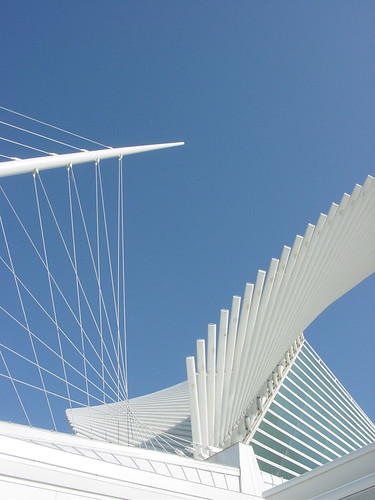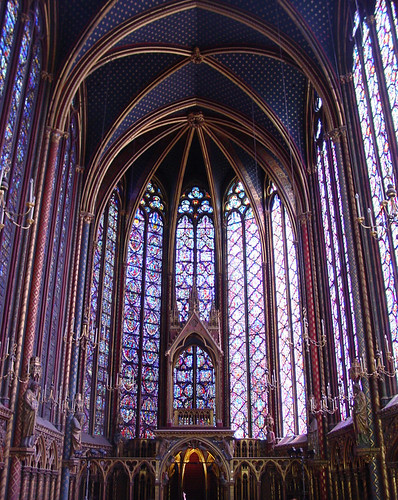
Archiyogitect
An architect who practices ashtanga yoga, calorie restriction optimal nutrition (CRON) and Buddhism
Sunday, December 30, 2007
Sunday, November 18, 2007
Saint Chapelle interior, Paris
My friend Victor has uploaded many of his architecture and nature photos. Here is one of Saint Chapelle
Saturday, May 26, 2007
Notes from Daniel Liebskind interview
His Jewish Museum in Berlin survived the criticism of many. One of the mayors of the city said the design was so unusual, that you could not get rid of it. Had he designed a box, he could have gotten rid of it.
A building is not just a technological object, it's a tale, a story. The underground connection between the historic and the new building at the Jewish Museum in Berlin says that the connection of Jews to Berlin is in the ground; they helped build the city. There is a cornered room meant to evoke the emptiness suffered by those on the way to the chambers. The single window in this space means the hope felt by a survivor who saw light coming through the cracks of trains taking her to a concentration camp.
The interviewer asked Liebskind if he had seen a new play in New York where the characters include architects Mies Van Der Rohe and Phillip Johnson and Mies' client Mrs. Farnsworth. He had not. In one scene, Mrs. Farnsworth comments on Mies' design for her glass house: "Mr. Van Der Rohe, you only want to build a monument to yourself." Phillip Johnson interjected, "Mrs. Farnsworth, when you hire a master architect, you have to let him create something for you." Asked to comment on that, Liebskind said that Van Der Rohe and Johnson represented an era in architecture of authoritarianism. The architect told you what to do. The current trend in architecture is that it's an art form in which there is give and take, and compromises. The architect doesn't dictate. He or she needs to negotiate in a political arena.
Liebskind said that an architect cannot be a pessimist. There are careers, including political ones, where people can be pessimists and be efficient. But architecture has to be positive because it's about construction. If something is going to live, it has to be positive. Even the words surrounding our profession are positive - grounding, establishing a foundation, finding the horizon line. People believe the world can be improved by construction.
Liebskind played the piano at concert level and the accordion. The accordion, he says, has humble connotations, always associated with peasants and gypsies. His father got him an accordion because it was smaller to carry into the tenement in which they lived than a piano. Asked if he still performed the piano, he said no, that you need an audience for that. He now performs architecture.
Music, Liebskind said, is mathematical and geometrical, but the result is emotional. It's the same with architecture. Its impact, if it's good, is atmospheric. Recently his wife gave him the gift of the complete works of Bach, a 160 CD set. Bach was incredibly prolific and it appears that he won't be able to listen to the entire works in his lifetime.
Liebskind said architecture is the most conservative of all arts. I'm curious of this statement, coming from a practitioner at the leading edge of the profession. Freud said that architecture is like an iceberg, or like the tip of Rome, located over layers of history. You cannot be an architect without understanding history. Spinoza said [things arrived at] easily are bad. Life is difficult.
There was a section of the interview dedicated to the master planning of the 911 site in Lower Manhattan. I didn't take many notes during this section. My recollection is that it was compared to the creation of the Jewish Museum in Berlin. It's an arena of tussle between a developer and his architect, the governor, the mayor, and the public. His design was inspired by arriving by boat to America and seeing the Statue of Liberty from the water. Today you arrive by jet and don't get the same impact that you get arriving by boat in to the NY harbor, to be greeted by the statue, and then by the marvel of a city created on an island. The interviewer commented that it was so nice that Liebskind, an immigrant who is a citizen was so patriotic. Liebskind responded that patriotism is great, one should not be embarrassed by it. It is often put down by rhetoric and jingoism.
The interview questions and answers where flowing nicely, until the interviewer read the question of someone who asked the inane question that architects are usually attacked with. It was something like, "Is great architecture the result of a big ego?" There was a pause, as Liebskind felt he was being attacked. He responded that "creating architecture is not about ego. You, the architect, are responsible for your creation. You sign your name on the drawings. Only stupid architects exercise their ego." At this point, in my opinion, the interviewer made matters worse by asking if in his opinion there were architects who had problems with the ego. His response was that, "architects without ideas feel they have to create facades in order to create things that look important."
Ouch! I don't blame him for whatever he said. It's difficult to be attacked and it takes a lot of grace to respond. This thread on the ego and the profession has engendered some discussions with fellow architects. It's true that there are some architects that possibly have egocentric problems that cause them to hiss in such a way that it deflates and demoralizes those around them. Any profession would have people like that. But what happens in our work is that our work is attacked, so we have to develop a resilience. We have to have vision and believe in what we're proposing. It is true, as Liebskind mentions, that in architecture you have to negotiate. Heck, even Pei years before said that architecture is politics. And someone who maneuvered through the politics of putting a pyramid in the middle of the Louvre's plaza should know.
After the lecture, I bought one of Liebskind's books, which he signed. I mentioned that I attended Penn, where he lectured. Penn's dean of architecture, Gary Hack, is a planner and worked with Liebskind on the winning scheme for the master plan of the World Trade Center Redevelopment.
Thursday, April 19, 2007
Peer Amid The Stars
Beginnings
Osvaldo's firm, Toro Ferrer, was the architect for the Caribe Hilton Hotel. Many years later, as an employee of Beame Architectural Partnership, I had the opportunity to work on the project of Paseo Caribe, which included a new casino for the hotel, structured parking, casitas, retail and entertainment center, and a condominium tower. Osvaldo's firm's most notable work, however, is the Supreme Court of Puerto Rico, which is across the Paseo Caribe site. Osvaldo's son, Javier, who studied at Penn a few years after I graduated from there, teamed up with the nephew of Osvaldo's partner Miguel Ferrer, and resumed the name of the firm. This is their current website.
William Biscome was a founder of Metropolitan Builders, which did a lot of housing and apartment buildings in a time when the population of the island was growing. Here is an example of one of their apartments. The firm they started still exists under the name of Desarrollos Metropolitanos, dedicated to all types of large scale construction projects.
When I was growing up there was a lot of construction where I lived, in the beach resort town on the east coast of Puerto Rico of Fajardo. I'll have to dedicate some time to describing Fajardo and its surroundings at another time.


